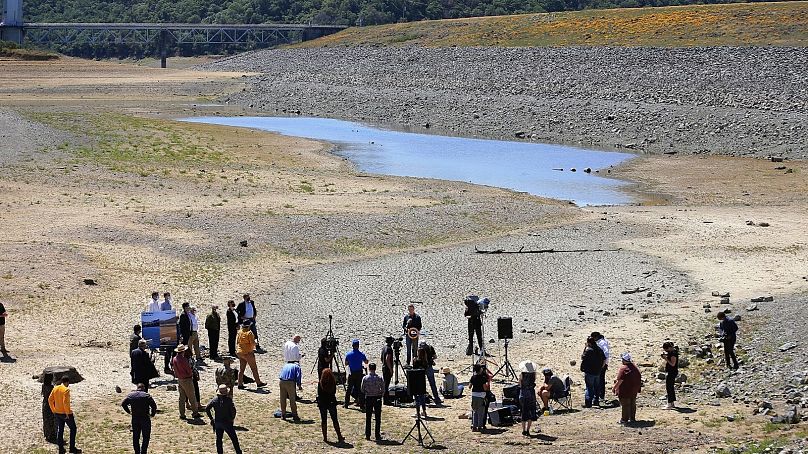It's now possible to buy California's water supply through future trading - but its impact on the planet is somewhat ambiguous.
Last year, for the first time, it became possible to trade water on Wall Street through futures contracts. Normally reserved for commodities like oil or precious metals, water became the latest asset to join the financial market. But how could this practice impact the planet?
The trading in the future prices of highly-prized commodities, where buyers agree to purchase an asset at a set date in the future for an agreed price, began in Japan in the seventeenth century with the trading in rice futures.
The latest commodity to begin trading in futures is water supplied in American’s most populous state, California.
Run by CME Group, Nasdaq Veles California Water Index futures (ticker symbol: NQH2O) launched in October 2018. Its unit prices of water are based on the volume of water required to cover an acre of land to a depth of one foot.
California has low rainfall and there are huge demands on its limited water supply from agriculture, industry and residents. By enabling purchasers to fix the price of water they will buy at a future date, it should enable them to plan and manage their water consumption more economically, but could this new practice benefit the environment too?
“The trading of water futures can help route the water to where it gets the best economic use, but this is not necessarily the best use for society and the environment,” says Sudeep Maitra, partner and specialist in utilities and energy transition at Boston Consulting Group. Still, there may be some small gains for the environment, he adds.
“If someone has a water future and they know the price of water is going to be priced at a particular rate in the future, they may start investing in better recycling, water reuse and efficiency measures, better water storage facilities and rainwater harvesting, etc," explains Maitra.
"It may also incentivise investment in biodiversity services to ensure that there is clean water flowing through streams and rivers and lakes. The futures market can enable these things if designed correctly, but that is a big if.”
Water futures are primarily finance-driven
The California water futures market is designed to be financially settled and the index underlying it doesn’t correspond to anyone’s actual risk, this makes the usefulness of the water futures market to the environment unclear for several reasons, argues Dr Bradley Franklin, economist for the global environmental non-profit, The Nature Conservancy.
“First, it's still in the early stages and has had few trades thus far, which raises questions about liquidity," Franklin explains.
"Second, because there is no physical delivery of water via the futures market, it's purely a way to limit financial risk. A buyer would still have to secure water on the spot market and deal with all the transaction costs that entails.
“Third, the way that the underlying water index is constructed leaves out transaction costs and water losses, which are typically big factors in any water trade," he continues, "changes in the index will give some measure of general water scarcity, but the likelihood that it will align directly with the actual cost of procuring water faced by any one party is quite low.”
Why is water scarce in California?
The California water futures market is not designed to truly benefit the environment, because it does not get to the root cause of why fresh, usable water is getting scarcer in the state, adds Basav Sen, director of the Climate Policy Project at the Institute for Policy Studies.
“The only plus side of creating a speculative financial market could be a certain measure of price stability and predictability. It does not address the underlying causes of the water scarcity," says Sen.
“Water scarcity is driven by climate change and pollution and unless you address and reverse climate change and pollution you are not going to get at the underlying causes driving this crisis in the first place.
"Water will continue to become scarcer and prices will rise. In this context, providing predictability for prices benefits water users, such as farmers, only to a small extent because that occurs against the backdrop of the prices going up.”
Price stability offers reassurance
Price certainty, introduced by water futures, does have a part to play in helping to solve California’s water problem, says a spokesperson for the CME Group, which runs the Nasdaq Veles California Water Index futures.
“We believe our Nasdaq Veles California Water Index futures contract can be a part of the solution to the California water challenge. Our water futures contract is already creating greater transparency into future water price expectations, helping a broad array of California’s physical water market participants to better align supply and demand.
“By providing price certainty today for commercial water needed in the future, this contract can help farmers and commercial water users manage their financial risks, ideally supporting other potential initiatives, such as the development of new water-efficient technologies and sustainable agriculture practices.”
Other areas of the world suffering from water shortages will be watching the development of the California water futures market with interest. It’s an economic initiative first and foremost, however.
Like many in the environmental space, Dr Franklin, at The Nature Conservancy is sceptical about how useful the futures market will be for helping ensure the health of environmental assets. Or more broadly, in dealing with environmental justice issues, such as those involved in the case of drinking water contamination in Flint, Michigan.
“I think that such problems revolve around fundamental failures of governance and a systematic tendency to underfund the programmes that would address these kinds of problems,” he says.
“Financial innovations, such as the futures market, seem far removed from these problems or their solutions.”












